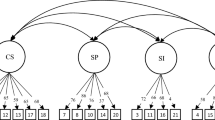Abstract
It has been over 30 years since the creation of the Bem Sex Role Inventory (BSRI; Bem in Journal of Counseling and Clinical Psychology, 42, 155-162, 1974). Although the BSRI is the most frequently tested instrument for measuring gender orientation, no researchers to date have examined its psychometric properties in Taiwan. Using the short version of the instrument, I asked a total of 381 men and 450 women college students, nurses, police officers, or managers in Taiwan to evaluate themselves on the BSRI. Among the findings are (1) satisfactory internal consistency of the BSRI, (2) more complex structure of masculinity and femininity than originally reported, and (3) doubtful ability of the BSRI to differentiate gender role orientation. These results suggest use of the BSRI in Taiwan with extreme caution before further validation of its applicability is conducted.
Similar content being viewed by others
References
Ballard-Reisch, D., & Elton, M. (1992). Gender orientation and the Bem Sex Role Inventory: A psychological construct revisited. Sex Roles, 27, 291–306.
Bem, S. (1974). The measurement of clinical androgyny. Journal of Counseling and Clinical Psychology, 42, 155–162.
Bem, S. (1981). Bem Sex Role Inventory Manual. Palo Alto, CA: Consulting Psychologists.
Campbell, D., & Fiske, D. (1959). Convergent and discriminant validation by multitrait–multimethod matrix. Psychological Bulletin, 56, 81–105.
Campbell, T., Gillaspy, Jr. J., & Thompson, B. (1997). The factor structure of the Bem Sex Role Inventory (BSRI): Confirmatory factor analysis of long and short forms. Educational and Psychological Measurement, 57, 118–124.
Choi, N., & Fuqua, D. (2003). The structure of the Bem Sex Role Inventory: A summary report of 23 validation studies. Educational and Psychological Measurement, 63, 872–887.
Hinkin, T. (1998). A brief tutorial on the development of measures for use in survey questionnaires. Organizational Research Methods, 1, 104–121.
Hoffman, R., & Borders, L. (2001). Twenty-five years after the Bem Sex Role Inventory: A reassessment and new issues regarding classification variability. Measurement and Evaluation in Counseling and Development, 34, 39–55.
Holt, C., & Ellis, J. (1998). Assessing the current validity of the Bem Sex-Role Inventory. Sex Roles, 39, 929–941.
Hong, C., & Rust, J. (1989). Androgyny and openness to experience in a Chinese population. Social Behavior and Personality, 17, 215–218.
Kerlinger, F., & Lee, H. (2000). Foundations of behavioral research. Orlando, FL: Harcourt.
Keyes, S. (1984). Measuring sex-role stereotypes: Attitudes among Hong Kong Chinese adolescents and the development of the Chinese Sex-Role Inventory. Sex Roles, 10, 129–141.
Lau, S. (1989). Sex role orientation and domains of self-esteem. Sex Roles, 21, 415–422.
Lau, S., & Wong, A. (1992). Value and sex-role orientation of Chinese adolescents. International Journal of Psychology, 27, 3–17.
Lee, M., (1992). The psychology of women. Taipei: Da-Yang (In Chinese).
Lenney, E. (1991). Sex roles: The measurement of masculinity, femininity and androgyny. In J. P. Robinson, P. R. Shaver, & L. S. Wrightsman (Eds.), Measures of personality and social psychological attitudes (pp. 573–660). San Diego, CA: Academic.
Leung, C., & Moore, S. (2003). Individual and cultural gender roles: A comparison of Anglo-Australians and Chinese in Australia. Current Research in Social Psychology, 8, 302–316.
Lu, L., & Wu, H. (1998). Gender-role traits and depression: Self-esteem and control as mediators. Counseling Psychology Quarterly, 11, 95–107.
OcKany, T., & Lajunen, T. (2005). Masculinity, femininity, and the Bem Sex Role Inventory in Turkey. Sex Roles, 52, 103–110.
Pedhazur, E., & Tetenbaum, T. (1979). Bem Sex Role Inventory: A theoretical and methodological critique. Journal of Personality and Social Psychology, 37, 996–1016.
Peng, T., Peterson, M., & Shyi, Y. (1991). Quantitative issues in cross-national management research: Trends and equivalence issues. Journal of Organizational Behavior, 12, 87–107.
Peng. T., & Wang, T. (2006). Women in Taiwan: Social status, education, and employment. In C. S. Granrose (Ed.) Employment of women in Chinese cultures: Half the sky (pp.84–106). Northampton, MA: Elgar.
Redding, G. (1990). The spirit of Chinese capitalism. Berlin: de Gruyter.
Sugihara, Y., & Katsurada, E. (1999). Masculinity and femininity in Japanese culture: A pilot study. Sex Roles, 40, 635–646.
Wang, T., & Creedon, C. (1989). Sex role orientations, attributions for achievement, and personal goals of Chinese youth. Sex Roles, 20, 473–486.
Yang, K. (1996). Psychological transformation of the Chinese people as a result of societal modernization. In M. Bond’s (Ed.) The handbook of Chinese psychology (pp. 479–498). Hong Kong: Oxford.
Zhang, J., Norvilitis, J., & Jin, S. (2001). Measuring gender orientation with the Bem Sex Role Inventory in Chinese culture. Sex Roles, 44, 237–251.
Acknowledgements
Special thanks to Julia R. Peng and H. C. Weng for data analysis. This study is based on a larger project funded by the National Science Council of the Republic of China in Taiwan (NSC 93-2416-H-214-001).
Author information
Authors and Affiliations
Corresponding author
Rights and permissions
About this article
Cite this article
Peng, T.K. Construct Validation of the Bem Sex Role Inventory in Taiwan. Sex Roles 55, 843–851 (2006). https://doi.org/10.1007/s11199-006-9136-6
Published:
Issue Date:
DOI: https://doi.org/10.1007/s11199-006-9136-6




